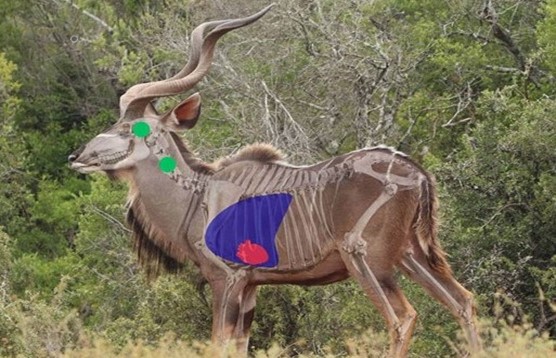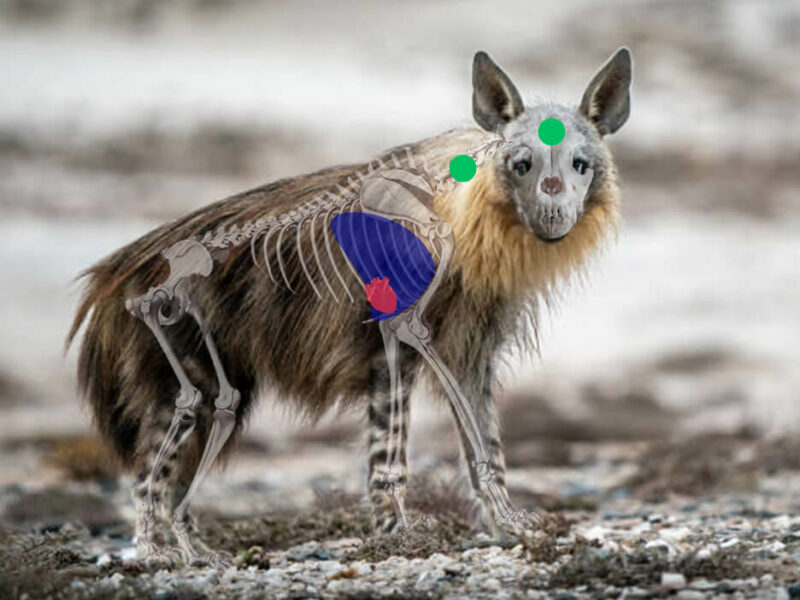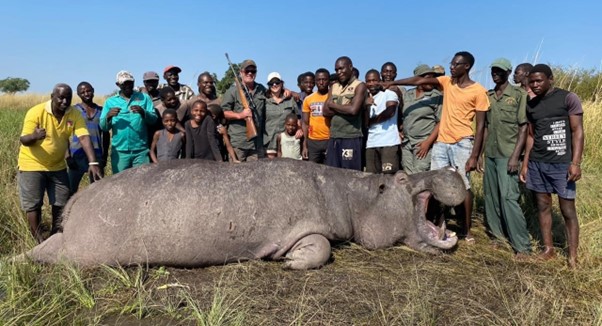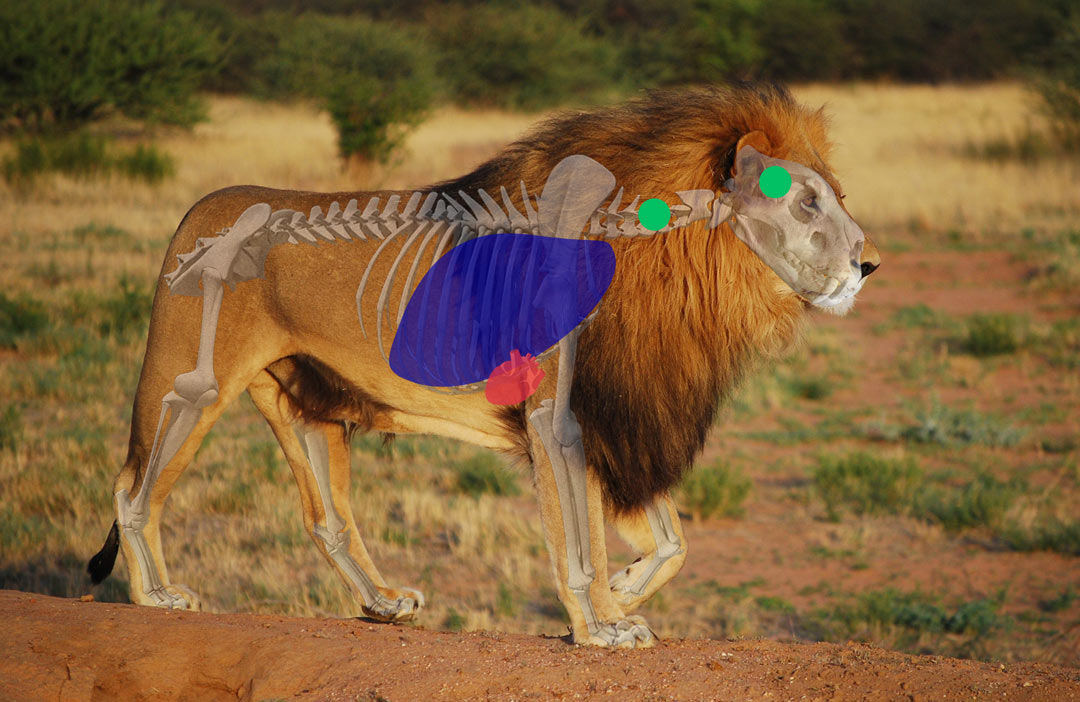So, are you ready for your African big game hunt? After all the planning, strategizing, paying, packing, and traveling, the success of the hunting safari pivots around a single split second. Onwards and upwards to celebrate success, or down to dwell in the darkness of doom and gloom and the acknowledgment of failure within that moment.
Successful shot placement is what it is all about. Are you mentally, physically, and emotionally prepared for this moment of truth? The game changes in an instant, transforming moments of calmness and tranquility into potential ages of mayhem and chaos.
Shot placement on an African big game hunt can turn the tables in the hunter’s favor or place the sought-after African Big Five animal at the top of the podium. Shot placement can swing the balance between life and death. But hey, if it were easy, everyone would take on an African big game animal and survive to tell the tale!
[DYNAMIC-BLOGTABLEOFCONTENT]
My Lion Hunt Shot Placement
We hunted the below lion a few years back in the Kalahari, South Africa. If you have not hunted a lion as yet, in fenced areas of over 4,000 acres, or free-range somewhere in Africa, let me confirm that a lion hunting safari is highly recommended.
We stalked this lion on foot for about two hours and eventually caught up with him lying in the long grass under an acacia tree.
The lion stood up and presented me with a frontal heart shot. Aiming, without much time at about 20 yards, the bullet entered the chest. The lion jumped and did a few mid-air circles before running about 50 yards and quickly expiring. I was thankful to have an exceptionally experienced dangerous game professional hunter who had completed over 1,500 lion hunts at my side. The lion turned out to be my first recorded dangerous game cat.

Hard work, planning, and preparation go into planning your dream African hunt. Depending on the adversary, hours of walking, hitting the gym, and stepping on the treadmill are on the cards.
The above still excludes all the time spent on load development, checking the gear, as well as trips to and from the shooting range. Non-hunters do not always understand the dedication and commitment that goes into ensuring a successful African hunting safari.
The hunter can have researched and purchased the most expensive rifle, equipped with top-of-the-range bullets, but this alone will not guarantee success. Poor shot placement, besides placing the members of the hunting safari at risk, will not ensure a quick and humane kill. Whether African plains game hunting or hunting the dangerous 7 in Africa, poor shot placement on the African hunting trip can result in a day or days of stress and misery that could possibly have been avoided.
Not only must the hunter, under varied conditions, be able to place the bullet exactly where he/she is aiming, but they need to be able to know the exact point of entry to seek the desired effect i.e., a brain or heart/lung shot.
Where would the Correct Aiming Point be while on an African Hunt?
- Ethical hunting is all about ensuring a quick and humane death for the animal. After all, we as hunters love God’s creatures, and causing the animal to suffer is certainly not the intention.
- The vast majority of shots that should be considered by the hunter would be a heart shot as the animal is presenting the hunter with a larger target.
- Heart shots, like when crocodile hunting, or hippo hunting, while the crocodile or hippo remains in the water, cannot always be considered as a first option.
- In other instances, head and brain shots should only be considered when the animal, such as an African elephant, Cape buffalo, or hippo is charging the hunter and there literally is no other choice to consider.
- When taking the heart shot, the best choice, if presented, would be when the animal is standing broadside (excluding when crocodile hunting), and the bullet is placed one-third of the way up.
- Not all animals’ hearts sit in this position, so it is worth the time and effort to investigate the exact heart placement on specialty animals such as giraffes, etc.
- Shot placement can substantially vary for some species of African game animals, so be sure to do the research.
Read more about shot placement on specialty game animals.

Crocodile Hunting in Mozambique and My Shot Placement
In 2022, we headed off to Mozambique for a crocodile hunting safari. I had done my research and was prepared to shoot the crocodile in the head, taking the side brain shot. I loaded my 300 Win Mag with 220-grain monolithic tips, and she was “in” and ready.
From the side perspective, the brain of a crocodile sits “above the smile” and “behind the eye.” I had been focusing for weeks on aiming for this exact spot.
On arriving in Mozambique, it turned out that in that part of Africa, they hunt them a little differently, in a three-shot sequence, namely:
- First shot through the neck of the crocodile to anchor the dinosaur.
- Second shot into the brain.
- And the third, into the heart and lungs from the side.
When crocodile hunting in Mozambique, they follow this sequence to ensure that the animal does not move because if the crocodile rolls, it could be into the murky depths, and gone would be the game hunting trophy.
Anyway, having all the time in the world, shooting from a distance of about 100 yards over an estuary of Lake Cahora Basa, using death grip sticks, I was ready to follow that sequence. I was a little thrown off course as I had mentally prepared for the first shot to be a side-brain shot but adapted as best I could.
Well, the first hit the neck perfectly, the second went through the heart and the third took off a chunk of the crocodile’s head. Luckily for me, the crocodile was a tank with a huge head, plus I do know a good taxidermist!
Either way, when crocodile hunting, ensure that you are shooting with a high-powered rifle and that the hunter is confident in terms of precision shooting. Crocodile hunting is all about placing the bullet exactly where you want it, resulting in optimum and perfect shot placement.
I can categorically state that I would have been heartbroken if the crocodile had rolled off into the swampy waters never to be seen again. Crocodile hunting is most certainly recommended. If one of these prehistoric man-eating beasts has not been included in any previous African hunt, add this safari to your bucket list.
Discover more about the intricacies of shot placement on a crocodile.

Shot Placement and African Cats
Many international hunters have a dream, an African hunting trip for lions and leopards in Africa. The same also applies to cheetah hunting in Namibia. Smaller cats such as genet, serval, caracal, and African wild cats are also becoming sought-after game hunting safaris.
As these cats are nocturnal, they are often hunted in conjunction with other night critters such as honey badgers and porcupines. Hyena hunting is also becoming a sought-after African hunting safari.
When hunting African cats, the hunter needs to remember that these cats have vitals that sit just a little further back and lower than when hunting African plains game.
The hunter will need to visualize the exact location of the heart and lungs and target the bullet correctly, no matter the circumstance. Cats also have a habit of stretching or either reaching up for bait or lying down. The hunter must know the exact position of the heart within the chest cavity under any circumstance or position.
Learn more about shot placement on African cats.
Shot Placement and the Boiler Room Pressure
Game hunting for African plains game antelope needs a little more work if the hunter is used to hunting outside of Africa.
While the anatomy of African antelope is similar to species within the USA or those found in Europe, there are exceptions, and the hunter would be wise to investigate and have a few lengthy discussions with a professional hunter.
The entire hunting safari revolves around the moment that the hunter squeezes the trigger. Besides waiting for the desired game hunting trophy to possibly turn into the correct position, the hunter still needs to personally be able to contend with:
- Excitement
- Fatigue
- Ensuring that breathing is regulated
- Panic that the animal may turn out of position or bolt
Under such pressure, hunters when hunting humped shoulder antelope such as Wildebeest or Gemsbuck (Oryx) often forget to factor in the height of the shoulder, resulting in shot placement that is too high.
An African hunting safari is not easy and comes with many challenges. When hunting from a position of a blind, or a similar structure, the hunter can relax and will wait for the animal to enter the shooting area. This method of game hunting is vastly different from walking and stalking an animal that may be on high alert, creating even more pressure for the hunter.
On a recent hyena hunting safari in Limpopo, South Africa we spent seven days and nights travelling hundreds of miles. It is stressful realizing that all the effort by outfitters and professional hunters, can only be converted into a success based on the perfect shot placement, which has to be taken “in the heat of the moment.”

On a recent safari while hippo hunting in Namibia, Caprivi Strip (Zambezi Region), I was dead adamant about shooting a bull hippo out of the water at roughly 30 yards. That was the plan, and that is what we had mentally prepared and practiced for.
A week before the hippo hunting safari, the outfitter called and asked if did not want to cancel and arrange another date as the entire area was still under water after the heavy summer rainfall.
Changing the dates of the safari was not an option. I was dead set on executing the plan of action. Anyway, for days we scouted the area looking for a suitable hippo. We just could not find any on land. We even considered going to a local chief and considered the possibility of hunting a hippo at night using a few various techniques. We chose not to.
The reality began to dawn on me that this hippo hunt was going to take place in the water. My first concern was that I would make use of the outfitter’s .375 rifle which was not my own. In the water, the only shot we would have would be a frontal brain shot or a side brain shot. The target, which sits either between the eyes or from the side between the ear and eye, is tiny. I had recently recovered from a shoulder surgery so had not practiced as much as I should have, especially for a brain shot. Additionally, the target moves and bobs around in the water, adding to the pressure.
In the back of your mind, the hunter still considers how much hard-earned has been spent on the hunting safari, but what can you do? Nothing, you are committed, and I was certainly not planning to go home without my trophy hippo!
After lining up on one or two hippos in the water, I was not feeling great about the shot (must have been a mental block) and on both occasions decided not to squeeze the trigger.
A couple of days before the end of the safari, at about 350 yards out we came across a hippo partially out of the water. Pulling our mokoro to the embankment, I raced up the embankment, lay on what felt like a ninety-degree angle, and focused on shot placement.
I was shaking so much, that wisely I decided to place that first shot on hold. The hippo moved into position, and I squeezed off the shot. The hippo sank into the water, out of sight. I cannot explain the amount of stress I felt waiting for the hippo’s stomach contents to create the gasses needed to make it float.
Eventually, the hippo appeared from the depths, and we recovered the carcass. My bullet was nowhere near the brain, and I had severed the spinal cord, about a foot away from the target area (Such things one should not confirm in writing!😊). While I was delighted to have the hippo, poor shot placement got me worked up.
An inch either way, and my hippo, along with my safari expenses, would have disappeared into the Chobe River, running parallel to my levels of failure. It worried me to such an extent, that we have in fact booked another hippo hunting safari. This time it is during the dry season. I think as I get older, my shot placement is getting worse, so I need to have larger animals out of the water and opt only for the preferred heart shot!

Shot Placement and Night Optics
Hunting nocturnal critters is quite different from hunting African big game during daylight hours. We recently went on a hyena hunting safari, searching for a spotted hyena.
Again, my bad, I was not 100 percent prepared for the hyena hunt. Having been working day and night, the hyena hunting trip was supposed to be more of a holiday, but that is a story for another day
I was under the impression we would be baiting hyenas and shooting under artificial light. Yes, I should have checked way before. Regardless, it turned out that we were going to be using night vision, a first for me. I really battled with the optics and later found out that because of being far-sighted, the images appeared better when using my glasses. Bottom line, if planning a hunting safari for night critters, get some practice in before the hunt.
Shot placement is a little trickier when using this kind of equipment and practice is needed. I have subsequently purchased my own night vision scope to ensure that this type of error does not reoccur in the future.
It All Comes Down To Shot Placement
Ethical hunting is all about the emphasis on decent shot placement. While the hunter may not always “get it right,” at least there will be peace of mind knowing that the correct pre-safari training and preparation programs were conducted.
Author: P.C. van Wyk
